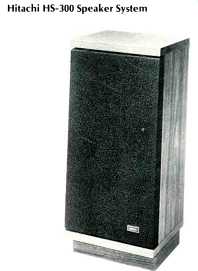
MANUFACTURER'S SPECIFICATIONS:
System Type: Two-way, vented, floor type.
Drivers: Woofer, 8-in. (20-cm.) gathered-edge suspension; tweeter, 2 ½-in. (6 1/2-cm.) cone type.
Frequency Response: 55 to 16,000 Hz,-8 dB; 45 to 19,000 Hz, -15 dB.
Crossover Frequency: 3.8 kHz.
Nominal Impedance: 8 ohms.
Maximum Input Power: 50 W (music).
Dimensions: 11 1/2 in. W x 27 in. H x 10-5/8 in.
D. Weight: 28.6 lbs.
Price: $189.95.
The Hitachi HS-300 is a two-way, vented-box speaker system. In place of the more traditional outer edge surround, the Hitachi woofer uses a gathered-edge type of suspension which looks like the bellows of an accordion when viewed from the front. One's first impression is that this rigid-looking fold shouldn't work, but a slight finger pressure on the cone quickly shows that it not only moves, but moves a great distance very freely. Great care has obviously been taken in the design of the woofer itself, and it uses an aluminum voice-coil bobbin, both aluminum and copper shorting rings in the magnet circuitry, and a coating on the back side of the cone to prevent breakup.
The cone tweeter is mounted behind what Hitachi refers to as an acoustic lens, which to this reviewer more nearly resembles a diffraction grating. Whatever you call it, the lens does provide good horizontal dispersion of the very high frequencies.
The enclosure is a vented system of 30-liter volume (1830 cu. in.) which has a suitable amount of absorbing material included to provide a high degree of internal damping.
Designed as a floor-standing system, the enclosure is finished on the sides and top with natural wood. Connection is made to well-marked, quick-access terminals in a recessed cavity on the rear of the enclosure. The front grille cover is removable, but in the absence of controls it is unlikely that the user need concern himself with this feature.
A very thorough set of measured curves accompanies each speaker, which is really "putting it on the line" for any manufacturer. This, coupled with a well-written instruction manual, is a real help to the user in obtaining the best performance in his (or her) listening situation.
A three-year warranty is extended to the original purchaser against defects in materials and workmanship.
Technical Measurements
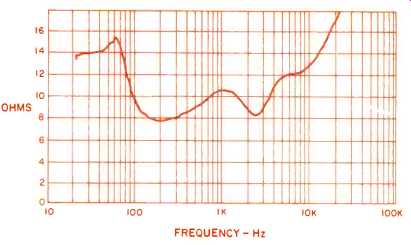
Fig. 1-Impedance.
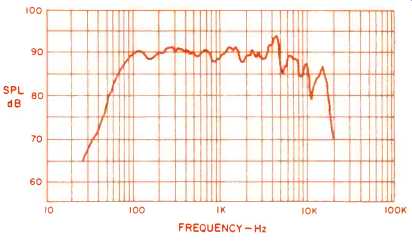
Fig. 2-Anechoic amplitude response at one meter with one-watt input.
The measured impedance as a function of frequency is shown in Fig. 1. The Hitachi HS-300 is a vented enclosure, but is suitably packed with absorbing material to make it a highly damped system. As a result, this system has a single resonance peak, rather than the two peaks generally found in the more conventional vented systems. The sharp-pointed, low-frequency peak and the flat slope of the low-frequency impedance are hallmarks of this class of design. This speaker can be safely considered to be an 8-ohm system from the standpoint of amplifier requirements.
Figure 2 shows the one-meter axial sound pressure level (SPL) for one-watt drive under anechoic conditions. The general response throughout the major frequency range is quite uniform and shows no structural acoustic difficulties.
The low-frequency performance is commendable down to about 70 Hz, then falling off in a well-mannered fashion.
The peak followed by a dip at around 4 kHz is attributable to diffractive scatter from the removable front grille frame, and the precise nature of the grille diffraction depends substantially on microphone position. The response is smoother in the 2 to 5 kHz region when the grille is removed, however, without the grille, the system is not as attractive as with the grille in place, and this could be an invitation to probing toddler fingers. Therefore, leaving the grille in place is recommended.
Figure 3 is the one-meter phase response corresponding to Fig. 2. The woofer and tweeter are in phase throughout the audible spectrum. The response has no discernable non minimum phase characteristics, and the only detractions from an otherwise excellent transient response will be due to the rapid amplitude and phase transitions at 4 kHz and 10 kHz.
The response to be expected in a room is shown in Fig. 4.
The HS-300 was placed on a carpeted floor and flat against a wall. The frequency spectrum of the first 13 milliseconds of "early sound" is plotted for an on-axis and for a left-channel stereo position, which are displaced 10 dB for clarity.
The rather wide dispersion of the speakers maintains the general frequency characteristic over the angular spread required for good stereo, however, floor placement takes a toll in middle-frequency response due to scatter. Depending on room layout, it might be advisable to experiment with an off-floor placement for greater accuracy of sound.
One interesting point with this test is that high-frequency response is better than middle-frequency response, where with the anechoic test, the reverse was true.
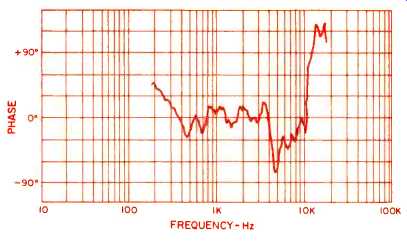
Fig. 3-One-meter phase response.
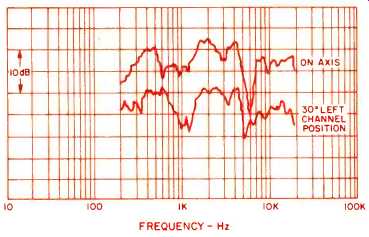
Fig. 4-Three-meter room test.
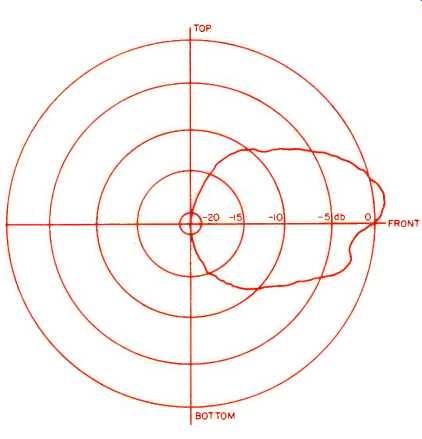
Fig. 5-Horizontal polar energy.
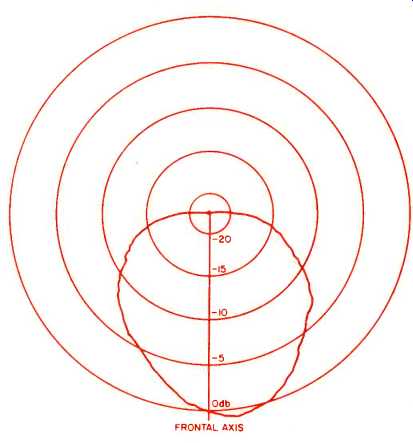
Fig. 6-Vertical polar energy.
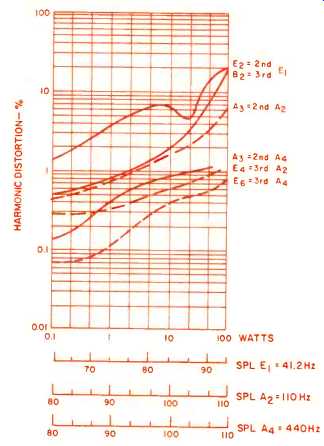
Fig. 7--Harmonic distortion for the musical tones E1 (41 Hz), A2 (110 Hz),
and A4 (440 Hz).

Fig. 8--Intermodulation of one to one.

Fig. 9--Energy-time plot.
The horizontal polar energy response is shown in Fig. 5, and good stereo imagery is indicated by this polar plot. The left-channel speaker of a stereo installation will be a little "hotter" than the right channel for average speaker placement, and will require a slight increase in level to the right speaker for optimum energy balance. The HS-300 has a wide dispersion of sound, and large objects, such as lamps, bookcases, and the like, should not be placed adjacent to the speaker if substantial reflection of sound is to be avoided.
Figure 6 is a plot of the vertical energy response. The sound is launched in a slightly vertical direction, as it should be for a floor-mounted system, but ceiling and floor reflections should be expected from a floor-mounted configuration, as this plot verifies.
Harmonic distortion for the musical tones E1 (41 Hz), A2 (110 Hz), and A4 (440 Hz) is shown in Fig. 7. Except for the lowest bass, the distortion remains quite low up to about 75 watts. The speaker shows a sudden distortion overload above about 80 watts average. The droop in the curve for E2 (82 Hz), the second harmonic of E1 (41 Hz), is due to non-linearities associated with the damping in the vent. Above 10 watts there is sufficient motion of air in the front-located vent that the damping material and the mesh grille on the inner side of the vent come into contact causing a "buzzing" sound. This sound was not discerned in the earlier listening test on musical material but can be heard on high level sine-wave test signals. While it is unlikely that a listener would play "flat" musical material at such a high level, this measurement does indicate that severe bass boost should not be applied to the HS-300. Figure 8 shows intermodulation of A4 (440 Hz) by E, (41 Hz). The IM is quite low all the way up to the maximum test level of 100 watts and is almost purely amplitude modulation.
The musical tones of middle C (262 Hz) and A4 (440 Hz) were used to check crescendo-handling ability. The acoustic transfer function decreases very slightly with increase in drive. A random crescendo 20 dB louder than a middle C inner voice will not noticeably reduce the level of the inner voice even up to a peak level over 300 watts. The HS-300 can thus handle hand claps and cymbal crashes without causing a muddying of a middle C tone. The tone of A4, however, is more affected and is reduced by almost one dB for peak crescendos of about 80 watts.
Figure 9 is the plot of received energy for a perfect transient pulse. This curve is the true envelope of the impulse response and shows an excellent initial transient, followed by diffraction signals. Almost the whole of the arrival from 3.6 to 3.8 milliseconds is due to scatter from the removable grille housing, as is the central peak at around 3.4 milliseconds. With these exceptions, the remainder of the energy-time plot indicates excellent transient response. The initial peak of energy at 3.05 milliseconds is due to the frequency components below 10 kHz while the smaller peak at 3.15 milliseconds is due to the spectrum above 10 kHz.
Because this is a vented system, the woofer was checked for its susceptibility to subsonic record-warp frequencies.
The woofer is clearly a long throw driver, but at very high levels it can be run out of its linear range by a warped record, producing a very unpleasant program modulation. I recommend that the preamplifier rumble filter be used for this system to prevent low-frequency cone excursions.
Listening Test
The listening test was performed under the conditions outlined by Hitachi in their excellent instruction manual.
The speakers were placed against a hard wall in a configuration such that the opposite wall, facing the speakers, was covered with drapery providing some sound absorption.
The floor was carpeted, which Hitachi recommends to provide de-emphasis of the bass level to some extent.
The overall impression of tonal balance, to this reviewer, was that the extreme low bass was absent, low and mid bass up to the octave below middle C was slightly prominent, the middle frequencies were somewhat irregular, and the extreme top was down in level. A modest touchup with conventional treble control is able to restore the balance on the high frequencies. Tone control equalization of the bass frequencies could not reduce the small amount of heaviness without dropping out too much low bass. A better cure, under the listening conditions for this review, was made by pulling the HS-300's slightly away from the wall. Some experimentation, however, may be necessary to suit individual preference for tonal balance.
The characteristic most apparent with extended listening is that the HS-300 is unobtrusive. It does not project any extreme coloration into reproduction which can cause listening fatigue. It has a polite sound which does not intrude upon enjoyment of good musical material. The lack of stridency gives a reasonably accurate presentation of piano and human voice.
The HS-300 has good transient response for percussion instruments. A good stereo stage presence exists for lateralization, and it isn't necessary to sit on a chalk mark to get good sound. A better stereo image was obtained, in this reviewer's opinion, by providing relatively wide speaker placement and angling the speakers toward the center of the listening area.
The stereo image tends toward a two-dimensional presentation. That is, instruments and voices are accurately placed in angular location but the sound appears compressed in depth somewhat like a motion picture screen.
This subjective impression was most evident for choral reproduction. This is, of course, a matter of taste and personal opinion and may not represent the way others perceive stereo presence on the HS-300. This speaker system can run out of 50 watts of amplifier rather easily. A great deal of this is because the low distortion of the speaker lets you "hang out" a bit more of the program before it begins to sound "loud." While not specifically pointed out by Hitachi, I would recommend the use of a two-ampere, fast-blow fuse to protect the speaker from damage if you like your music loud.
In summary, the Hitachi HS-300 gives a good acoustic account of itself and makes an attractive addition to any listening room.
-Richard C. Heyser
(Audio magazine, Mar. 1975)
Also see:
Infinity 1001 Speaker System (Apr. 1973)
JVC S-300 FM Stereo/AM Receiver (Sept. 1976)
= = = =